Fighting the Format: UW Cycling

Welcome back to Fighting the Format, the series in which I lay down the strategies of the best decks in the format moving into a given weekend – what they are, how they work, how they win, and – importantly – how to beat them.
The World Magic Cup has been and gone, and the eventual champions came to the surprise of no-one. Japan came packing not one, but two Hall of Famers, and both are widely considered a league ahead of other HoF members. Shota Yasooka, Yuuya Watanabe and their teammate Kenta Harane demolished the field and emerged victorious.
Alongside Japan came a number of great performances; a top 8 from TT’s own Sam Rolph backed up by Pip Griffiths and Aaron Boyhan; a top 4 from Italy, their third such finish in a row; and a sweet new take on an existing archetype, piloted by Poland’s own Piotr Glogowski – better known as ‘Kanister’.
The Deck
UW Cycling – Piotr Glogowski, Top 4 for Poland at World Magic Cup 2017, December 1st-3rd
| 2 Creatures |
| 2 Curator of Mysteries |
| 34 Non-Creature Spells |
| 4 Censor |
| 4 Renewed Faith |
| 3 Search for Azcanta |
| 1 Abandoned Sarcophagus |
| 3 Drake Haven |
| 4 Counterveiling Winds |
| 4 Hieroglyphic Illumination |
| 4 Cast Out |
| 4 Settle the Wreckage |
| 3 Fumigate |
| 24 Lands |
| 4 Irrigated Farmland |
| 4 Glacial Fortress |
| 1 Shefet Dunes |
| 1 Ipnu Rivulet |
| 8 Plains |
| 6 Island |
| Sideboard |
| 2 Torrential Gearhulk |
| 3 Regal Caracal |
| 4 Authority of the Consuls |
| 2 Jace’s Defeat |
| 2 Disallow |
| 1 Abandoned Sarcophagus |
| 1 Drake Haven |
Somehow, and despite a general distaste for UW shells, this is the third time I’ve looked at a UW list. I guess I just have to cycle through them? Hem.
How Does it Work?
Well, here we are again with a Control build. First, let’s look at the similarities between this and UW Approach:
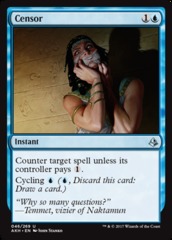
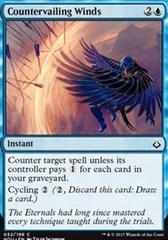
Countermagic. While Censor is a staple four-of in Standard Control, Countervailing Winds is a spicier addition – as a Miscalculation on steroids, Winds is going to hit pretty much anything you need it to for a long way into the game. When it’s dead? Cycle it away.
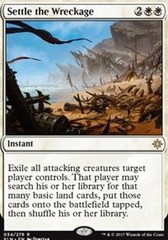
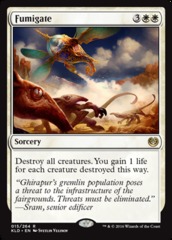
Removal. The one-two punch that keeps many good creatures down, Settle and Fumigate ensure that the board is clear whenever you need it to be. Bristling Hydra is not the threat it is against UR or UB Control that it is here! For any threats that are a bit trickier to remove, Cast Out has you covered. The Scarab God, Hazoret the Fervent, Chandra, Torch of Defiance; all fair game to get the boot.

Card draw. Search does it’s usual discount Jace, Vryn’s Prodigy impression here, acting as a card filterer early and a card draw engine late. As a bonus, it gives you a small boost in mana, allowing for key double-spell turns earlier in the game. Illumination fills the role usually played by Glimmer of Genius; in exchange for scrying two, you get to turn it into a straight-up cantrip for a single blue mana.
Renewed Faith acts generally as a two mana cycler with some upside, but has the occasional use as a straight-up life-gain spell; if you need to avoid a Lightning Strike being the last spell cast in a game, have Faith.
Countermagic, removal, and card draw. So far, I could have described one of any number of Control decks. The difference between this list and Approach?

Drake Haven is the win condition that UW needed. While Approach offers a total lack of interactivity, it costs a full fourteen mana to do so – Haven grants inevitability while affecting the board on the way, and starts at the low investment of three mana.
One of the big drawbacks of playing creature threats in a Control deck is that they turn on the opponent’s removal. Tapping out for a Torrential Gearhulk and drawing two cards during the end step is certainly good value, but if you were looking for it to actually interact with the board state, Harnessed Lightning and Abrade will rain on your parade! Haven neatly avoids this by creating as many Wind Drakes as you have cyclers. How many Wind Drakes is enough, you think? How about twenty-six!
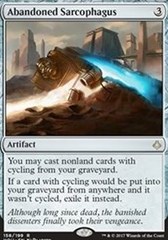
The remaining spells include a pair of Curator of Mysteries and a single Abandoned Sarcophagus. The Cultivator’s act as either a cantripping Drake or (occasionally) a budget Air Elemental, and the Sarcophagus buries the opponent in immediate card advantage. Sarcophagus masquerades as a Yawgmoth’s Will that is cheaper to cast, lasts the rest of the game, and turns each subsequent cycler into a cantrip.
The mana base is smooth, playing only two colours and the full eight dual lands. Key tip with this list – sandbag the single Shefet Dunes if you can. I’m sure Kanister ended plenty of his matches by casting a one-shot Glorious Anthem in his UW Control deck!
The sideboard offers the usual Control board package – extra counters for Control mirrors in Jace’s Defeat and Disallow, extra threats with Torrential Gearhulk and the fourth Haven, a good chunk of life gain with Regal Caracal and Authority of the Consuls for the aggro matchups, and a bit more card draw with Abandoned Sarcophagus. UW can’t board into too many non-cyclers as it risks seriously weakening it’s Havens, but it can certainly afford a few big upgrades.
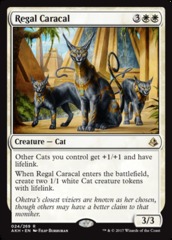
What is it’s Plan?
UW Cycling is a bit of an interesting animal. For the most part, it is a Control deck – counters and removal keep the UW deck alive, then card draw grinds the opponent out.
The difference lies in the games when UW slams an early Haven and it sticks. In these games, UW can take a more tempo-based role, turning of all it’s cyclers into Drakes, and countering the relevant spells the opponent puts on the stack.
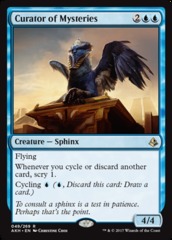
What Are its Strengths and Weaknesses?
Strengths
Consistency
When your deck plays twenty-six cyclers, you are going to get to see a lot of cards. UW can effectively churn through the deck looking for a given answer or threat, whether that’s a Fumigate to nab a bunch of thopters and their Whirler Virtuoso, or a Cast Out for an upticking Vraska, Relic Seeker.
Coverage
UW has the tools to answer any kind of permanent, and plays a full seven wraths – there is no board an opponent can present that UW cannot answer.
Inevitability
Unlike UB relying on a few copies of Torrential Gearhulk or The Scarab God and Approach relying on the titular spell, UW Cycling’s finisher is cheap to land and very difficult to interact with. Unless your opponent has managed to sneak an Abrupt Decay into their Standard deck, I wouldn’t expect to see many game one Appetite for the Unnatural!
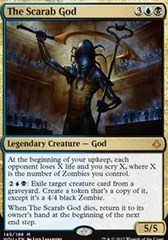
Weaknesses
Expensive
Though UW has many ways to cheaply use it’s mana thanks to Cycling, it has very few actually interactive spells before the four-mana slot. This means that cheap but must-answer threats like Glint-Sleeve Siphoner or Longtusk Cub are likely to hit the board, and then UW needs to lean very hard on the Wreckage/Fumigate package. A savvy player will utilise this mana taxation by avoiding playing into Settles where possible and forcing the UW opponent into an untimely Fumigate, which can then allow a Planeswalker or other resilient threat to stick.
Countermagic
As a follow-on from the above, cheap threats backed up by counterspells are the nail in the coffin for UW. An early Cub and Rogue Refiner can quickly get out of control if every wrath meets a Negate!
Artifact/Enchantment Removal
I jokingly mentioned Appetite for the Unnatural above, but I wasn’t kidding; Appetite and Slice in Twain give UW fits. They nab Haven, the key reason this deck exists. They make short work of resolved Sarcophagus’, effectively cutting five or more cards out of the opponents’ hand. They answer post-board Torrential Gearhulk, and even effectively counter opposing Cast Out to boot! If you come packing two-four Naturalise effects in the board and a couple of discard or counterspells, you should do just fine.
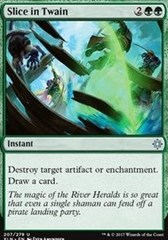
Play
Aggro
Ramunap Red does what it always does against Control – go way, way under them. UW in particular struggles very much with a fast start from an aggro deck, as it has no Harnessed Lightning or Fatal Push to handle a quick Bomat Courier amassing cards or a Kari Zev, Skyship Raider knocking chunks of it’s life total. Mono Black fulfils a similar role, applying a ton of pressure early and recursive threats late with Dread Wanderer and Scrapheap Scrounger.
Energy Midrange
Before I go further, let me be clear – your pre-board configurations of Temur or Sultai Energy will get crushed by UW. The reason to play these anyway? Duress, Negate and Appetite. These decks offer cheap and powerful threats that – backed up with disruption – should put the game away in short order. Pre-board you’ll be a reasonable underdog, but post-board you should find it reasonably difficult to lose.

Do Not Play
Combo
Combo decks like UW Gift aim to engineer some set of cards that, combined, create something more powerful than the sum of their parts. Refurbish on God-Pharoah’s Gift is a powerful play – Countervailing Winds trumps it.
Non-UW Control
UB, UR and other UW like Approach cannot beat UW Cycling. Drake Haven is too cheap a win condition, and too hard to interact with. The UW Cycling player can even start a countermagic fight to land Haven and win it! If you’re planning on playing non-UW Cycling Control, make sure you’re packing enchantment removal and a ton of counterspells, or you are toast.
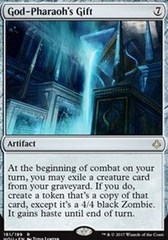
Summary
UW Cycling is a fresh take on an established archetype that has quickly replaced UW Approach’s share of the meta, and is a great example of a new deck shaking up an unsolved Standard format. Whether you’ve decided you want to Paul Cheon your way through a tournament with wraths and counterspells or sleeve up your Duresses and Negates, I hope this article has been a haven of knowledge for you.
If you have any questions or comments, please leave them below. As always, good luck!





